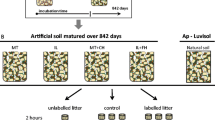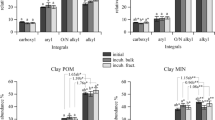Abstract
Adsorption of dissolved organic compounds onto mineral surfaces is increasingly recognized as a significant, if not dominant, carbon stabilisation mechanism in many soils. By utilising carbon-13 enriched dissolved organic carbon (DOC) source materials in a repeated leaching-sorption-incubation study, we show here that the biochemical composition of mineral-retained organic matter (OM) is similar across four different classes of clay minerals but the quantity and stability of this OM is both a function of source material and clay mineralogy. Three to eight times as much carbon was retained on a mass basis when the same amount of DOC derived from eucalyptus versus wheat litter was applied, and the retained wheat-derived OM was up to 2.4 times more degradable than that of the eucalyptus source. For both litter types, carbon retention across the clay types was not significantly different; whereas, the stability of the retained OM was different but depended on which litter extract had been applied. The wheat-derived DOC was more stable when retained by allophane and oxides than by illite and smectite. Solid-state 13C NMR spectroscopic results indicated that despite large compositional differences in both source litter and resultant DOC, the composition of the mineral-retained OM was similar across clay classes with lignin-derived aromatic and carboxylic compounds dominating. Differences in the amount of carbon retained were related to differences in the proportions of aromatic, phenolic and carboxylic C in the DOC produced from the two litter sources. Differences in the stability across the clay classes were correlated with the abundance of metals and short-range ordered minerals. These results suggest that whenever reactive mineral surfaces and metals are present in a soil, a similar form of relatively unaltered litter derived OM can be adsorbed but that the longer term stability of sorbed OM, and thus in situ composition, will be a function of the mineralogy (reactivity) of the specific minerals involved in the binding process.










Similar content being viewed by others
References
Arnarson TS, Keil RG (2000) Mechanisms of pore water organic matter adsorption to montmorillonite. Mar Chem 71:309–320
Baldock JA, Skjemstad JO (2000) Role of the soil matrix and minerals in protecting natural organic materials against biological attack. Org Geochem 31:697–710
Baldock JA, Masiello CA, Gélinas Y, Hedges JI (2004) Cycling and composition of organic matter in terrestrial and marine ecosystems. Mar Chem 92:39–64
Baldock JA, Sanderman J, Macdonald LM, Puccini A, Hawke B, Szarvas S, McGowan J (2013) Quantifying the allocation of soil organic carbon to biologically significant fractions. Soil Res 51:561–576
Butler JHA, Eickhoff CP (1979) A simple cabinet for growing C-14 labelled plant material. Lab Pract 28:28–30
Chapman HD (1965) Cation-exchange capacity. In: Black CA, Evans DD, White JL, Ensminger LE, Clark FE (eds) Methods of soil analysis. Part 2. American Society of Agronomy, Madison, pp 899–904
Chorover J, Amistadi MK (2001) Reaction of forest floor organic matter at goethite, birnessite and smectite surfaces. Geochim Cosmochim Acta 65:95–109
Chorover J, Amistadi MK, Chadwick OA (2004) Surface charge evolution of mineral-organic complexes during pedogenesis in Hawaiian basalt. Geochim Cosmochim Acta 68:4859–4876
Clark KR (1993) Non-parametric multivariate analyses of changes in community structure. Aust J Ecol 18:117–143
Coplen TB (2011) Guidelines and recommended terms for expression of stable-isotope-ratio and gas-ratio measurement results. Rapid Commun Mass Spectrom 25:2538–2560
De Troyer I, Bouillon S, Barker S, Perry C, Coorevits K, Merckx R (2010) Stable isotope analysis of dissolved organic carbon in soil solutions using a catalytic combustion total organic carbon analyzer-isotope ratio mass spectrometer with a cryofocusing interface. Rapid Commun Mass Spectrom 24:365–374
Eusterhues K, Rumpel C, Kleber M, Kögel-Knabner I (2003) Stabilisation of soil organic matter by interactions with minerals as revealed by mineral dissolution and oxidative degradation. Org Geochem 34:1591–1600
Feng XJ, Simpson AJ, Simpson MJ (2005) Chemical and mineralogical controls on humic acid sorption to clay mineral surfaces. Org Geochem 36:1553–1566
Gleixner G (2013) Soil organic matter dynamics: a biological perspective derived from the use of compound-specific isotopes studies. Ecol Res 28:683–695
Gu BH, Schmitt J, Chen ZH, Liang LY, McCarthy JF (1994) Adsorption and desorption of natural organic-matter on iron-oxide: mechanisms and models. Environ Sci Technol 28:38–46
Kaiser K, Guggenberger G (2000) The role of DOM sorption to mineral surfaces in the preservation of organic matter in soils. Org Geochem 31:711–725
Kaiser K, Kalbitz K (2012) Cycling downwards: dissolved organic matter in soils. Soil Biol Biochem 52:29–32
Kaiser K, Guggenberger G, Haumaier L, Zech W (2002) The composition of dissolved organic matter in forest soil solutions: changes induced by seasons and passage through the mineral soil. Org Geochem 33:307–318
Kalbitz K, Kaiser K (2008) Contribution of dissolved organic matter to carbon storage in forest mineral soils. J Plant Nutr Soil Sci (Zeitschrift Fur Pflanzenernahrung Und Bodenkunde) 171:52–60
Keiluweit M, Kleber M (2009) Molecular-level interactions in soils and sediments: the role of aromatic pi-systems. Environ Sci Technol 43:3421–3429
Kindler R, Siemens J, Kaiser K, Walmsley DC, Bernhofer C, Buchmann N, Cellier P, Eugster W, Gleixner G, Grũnwald T, Heim A, Ibrom A, Jones SK, Jones M, Klumpp K, Kutsch W, Larsen KS, Lehuger S, Loubet B, McKenzie R, Moors E, Osborne B, Pilegaard K, Rebmann C, Saunders M, Schmidt MWI, Schrumpf M, Seyfferth J, Skiba U, Soussana JF, Sutton MA, Tefs C, Vowinckel B, Zeeman MJ, Kaupenjohann M (2011) Dissolved carbon leaching from soil is a crucial component of the net ecosystem carbon balance. Glob Change Biol 17:1167–1185
Kleber M, Sollins P, Sutton R (2007) A conceptual model of organo-mineral interactions in soils: self-assembly of organic molecular fragments into zonal structures on mineral surfaces. Biogeochemistry 85:9–24
Kögel-Knabner I, Ekschmitt K, Flessa H, Guggenberger G, Matzner E, Marschner B, von Luetzow M (2008) An integrative approach of organic matter stabilization in temperate soils: linking chemistry, physics, and biology. J Plant Nutr Soil Sci (Zeitschrift Fur Pflanzenernahrung Und Bodenkunde) 171:5–13
Kramer MG, Sanderman J, Chadwick OA, Chorover J, Vitousek PM (2012) Long-term carbon storage through retention of dissolved aromatic acids by reactive particles in soil. Glob Change Biol 18:2594–2605
Leifeld J, Kögel-Knabner I (2001) Organic carbon and nitrogen in fine soil fractions after treatment with hydrogen peroxide. Soil Biol Biochem 33:2155–2158
Michalzik B, Tipping E, Mulder J, Lancho JFG, Matzner E, Bryant CL, Clarke N, Lofts S, Esteban MAV (2003) Modelling the production and transport of dissolved organic carbon in forest soils. Biogeochemistry 66:241–264
Mikutta R, Kleber M, Kaiser K, Jahn R (2005) Review: organic matter removal from soils using hydrogen peroxide, sodium hypochlorite, and disodium peroxodisulfate. Soil Sci Soc Am J 69:120–135
Mikutta R, Mikutta C, Kalbitz K, Scheel T, Kaiser K, Jahn R (2007) Biodegradation of forest floor organic matter bound to minerals via different binding mechanisms. Geochim Cosmochim Acta 71:2569–2590
Mikutta R, Schaumann GE, Gildemeister D, Bonneville S, Kramer MG, Chorover J, Chadwick OA, Guggenberger G (2009) Biogeochemistry of mineral-organic associations across a long-term mineralogical soil gradient (0.3–4,100 kyr), Hawaiian Islands. Geochim Cosmochim Acta 73:2034–2060
Miltner A, Bombach P, Schmidt-Brucken B, Kastner M (2012) SOM genesis: microbial biomass as a significant source. Biogeochemistry 111:41–55
Neff JC, Asner GP (2001) Dissolved organic carbon in terrestrial ecosystems: synthesis and a model. Ecosystems 4:29–48
Piccolo A (2001) The supramolecular structure of humic substances. Soil Sci 166:810–832
Qualls RG (2000) Comparison of the behavior of soluble organic and inorganic nutrients in forest soils. For Ecol Manag 138:29–50
Römkens P, Dolfing J (1998) Effect of Ca on the solubility and molecular size distribution of DOC and Cu binding in soil solution samples. Environ Sci Technol 32:363–369
Rumpel C, Eusterhues K, Kögel-Knabner I (2004) Location and chemical composition of stabilized organic carbon in topsoil and subsoil horizons of two acid forest soils. Soil Biol Biochem 36:177–190
Sanderman J, Amundson R (2009) A comparative study of dissolved organic carbon transport and stabilization in California forest and grassland soils. Biogeochemistry 92:41–59
Sanderman J, Kramer MG (2013) Differential production yet chemical similarity of dissolved organic matter across a chronosequence with contrasting nutrient availability in Hawaii. Biogeochemistry 113:259–269
Sanderman J, Baldock JA, Amundson R (2008) Dissolved organic carbon chemistry and dynamics in contrasting forest and grassland soils. Biogeochemistry 89:181–198
Scheel T, Dorfler C, Kalbitz K (2007) Precipitation of dissolved organic matter by aluminum stabilizes carbon in acidic forest soils. Soil Sci Soc Am J 71:64–74
Scheel T, Haumaier L, Ellerbrock RH, Ruhlmann J, Kalbitz K (2008) Properties of organic matter precipitated from acidic forest soil solutions. Org Geochem 39:1439–1453
Schmidt MWI, Knicker H, Kögel-Knabner I (2000) Organic matter accumulating in Aeh and Bh horizons of a Podzol: chemical characterization in primary organo-mineral associations. Org Geochem 31:727–734
Schmidt MWI, Torn MS, Abiven S, Dittmar T, Guggenberger G, Janssens IA, Kleber M, Kögel-Knabner I, Lehmann J, Manning DAC, Nannipieri P, Rasse DP, Weiner S, Trumbore SE (2011) Persistence of soil organic matter as an ecosystem property. Nature 478:49–56
Schnitzer M (2000) A lifetime perspective on the chemistry of soil organic matter. Adv Agron 68(68):1–58
Schöning I, Kögel-Knabner I (2006) Chemical composition of young and old carbon pools throughout Cambisol and Luvisol profiles under forests. Soil Biol Biochem 38:2411–2424
Sheldrick BH (1984) Acid ammonium oxalate-extractable Fe and Al (Mn and Si if desired). LRRI: 84-30. Land Resource Research Institute, Ottawa
Shevchenko SM, Bailey GW (1996) Life after death: lignin-humic relationships reexamined. Crit Rev Environ Sci Technol 26:95–153
Smernik R, Skjemstad J (2009) Mechanisms of organic matter stabilization and destabilization in soils and sediments: conference introduction. Biogeochemistry 92:3–8
Stevenson FJ (1982) Humus chemistry: genesis, composition, reactions. Wiley, New York
Sutton R, Sposito G (2005) Molecular structure in soil humic substances: the new view. Environ Sci Technol 39:9009–9015
Sutton R, Sposito G (2006) Molecular simulation of humic substance-Ca-montmorillonite complexes. Geochim Cosmochim Acta 70:3566–3581
Theng BKG, Churchman GJ, Newman RH (1986) The occurrence of interlayer clay-organic complexes in 2 New Zealand soils. Soil Sci 142:262–266
Tucker ME (1988) Techniques in sedimentology. Blackwell Scientific Publications, Oxford, p 394
Weishaar JL, Aiken GR, Bergamaschi BA, Fram MS, Fujii R, Mopper K (2003) Evaluation of specific ultraviolet absorbance as an indicator of the chemical composition and reactivity of dissolved organic carbon. Environ Sci Technol 37:4702–4708
Wershaw RL, Llaguno EC, Leenheer JA (1996) Mechanism of formation of humus coatings on mineral surfaces. 3. Composition of adsorbed organic acids from compost leachate on alumina by solid-state (13)C NMR. Colloids Surf A 108:213–223
Acknowledgments
This work was funded by a strategic appropriation grant from the CSIRO Sustainable Agriculture National Research Flagship. We would like to thank M Raven for XRD analysis, C Creamer, L Macdonald and M Farrell for thoughtful discussions during the development of this manuscript and an anonymous reviewer for insightful comments.
Author information
Authors and Affiliations
Corresponding author
Additional information
Responsible Editor: Jan Mulder
Electronic supplementary material
Below is the link to the electronic supplementary material.
Rights and permissions
About this article
Cite this article
Sanderman, J., Maddern, T. & Baldock, J. Similar composition but differential stability of mineral retained organic matter across four classes of clay minerals. Biogeochemistry 121, 409–424 (2014). https://doi.org/10.1007/s10533-014-0009-8
Received:
Accepted:
Published:
Issue Date:
DOI: https://doi.org/10.1007/s10533-014-0009-8




